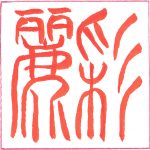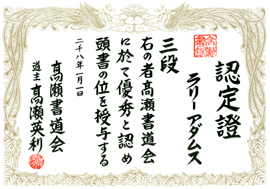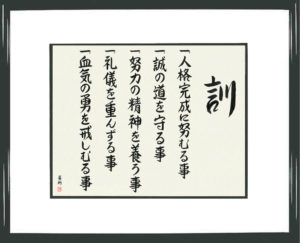Martial Arts Japanese Calligraphy
Takase Studios provides many services to meet all of your Martial Arts Japanese Calligraphy needs. For instructors, we have custom seal designs, calligraphy for Japanese logo elements, custom and stock images for your marketing materials and newsletters, dojo kun, and custom Japanese scrolls. For students, we offer full name translations for belts and certificates, gifts for your Sensei or Dojo, artwork, and even custom tattoo designs.
Japanese Martial Arts and Japanese Calligraphy are tightly connected with a tradition dating back even further than the well-known 17th-century writings of Miyamoto Musashi. We have been working with the Martial Arts community for more than a decade now creating master certificates, full names in Japanese for belts and certificates, seal designs, scrolls, calligraphy for school emblems and marketing materials, dojo kun, and even makimono with the school’s secret techniques.
Make sure you have the best. Each design is hand drawn by Master Japanese Calligrapher Eri Takase who in 1989 was awarded the rank of Shihan by Japan’s most prestigious professional calligraphic society, the Bokuteki-kai.

Custom Japanese Seal Design
Personal and school seals reflect your personality and that of your school. With our custom Japanese seal design we work with you to not only create the right translation but to also capture the look and feel that you would like.
Generally, there is a lot more leeway with personal seals. These can be more individualized, especially if it is for your own use. Instructor’s seals may want to follow the school tradition which may require a certain size, style (square, oblong, round), and translation method (katakana or phonetic translations to kanji). Think of the personal seal as your signature and how you would like your signature to look.
School seals are almost always strictly formal. This means square and using tensho (seal script) fonts. They are also usually larger than an inch.
This is an order for a custom design and so you would be working directly with Eri Takase and a translator to create a unique, custom work.
We would take you through each step of the process including options for translation, fonts, and the layout. Electronic samples are shown that we can discuss and modify as needed. You will have input into each step of the process and can direct the design to the final artwork.
The final design may be ordered as a high-resolution digital image or on flat, white, acid-free paper. From either a seal may be carved or the design may be used to create a rubber stamp as is commonly available.

Custom Master Rank Certificates
Work directly with Master Japanese Calligrapher Eri Takase to create a custom master certificate for your school or association.
We work with you on all aspects of the design including translation, layout, and font.
You may order the final certificate as a digital image from which you can print your own certificates, or you may order the final certificate that we would mail to you.
We also include a separate sheet that has all of the kyu and dan ranks.
The fee for the certificate is one time and you would then be able to create as many certificates as you like using this master certificate.
We only provide the Japanese calligraphy part of the certificate. Any English text you would have to do yourself or have done. Also, seal designs would need to be ordered separately.

Martial Arts Japanese Scrolls
Our Japanese Scrolls are really special and we are very proud of them. We have been working with our scroll maker in Nara, Japan for more than a decade and are the only one in the United States using these special scrolls.
Scroll Options
- 12 1/4″ W x 43″ H (31.1 cm W x 109.2 cm H)
- 18″ W x 72″ H (45.7 cm W x 182.8 cm H)
Creating scrolls is significantly more involved than our other offerings so we wrote an entire page dedicated just to the custom design and creation process that we use for scrolls. These scrolls are both a treat to work with and a treat to see.
The scrolls have silk borders and the materials are layered so that when displayed the scroll will hang straight and not warp over time. This is important. And the paper takes the ink just right so subtle brush strokes come out just as expected. I love these scrolls.
If you are interested in ordering a custom scroll, or in simply learning more about our scrolls and the process we use, please do visit our on Custom Japanese Scrolls page.
If you would like to see more scroll options, including our non-custom scroll catalog please click the button below.

Custom Japanese Art
Custom Japanese Art is always a nice touch to your school or home dojo. Whether your school name, style or motto we work with you to get just the look you want.
We offer four unframed options:
- 8″ x 12″ ( 20.3 cm x 30.5 cm)
- 12″ x 18″ (30.5 cm x 45.7 cm)
- 15″ x 22″ (38.1 cm x 55.9 cm)
- 24″ x 36″ (61.0 cm x 91.4 cm)
And one framed option:
- 16″ x 20″ (40.6 cm x 50.8 cm)

Full Name in Japanese
Takase Studios has been selected by several belt makers to provide full names in katakana so we have become very efficient and are able to offer this amazing price.
Out Names in Japanese Catalog is one of the best on the Internet as we include the pronunciation of the name along with the translation. This is important for international pronunciations. For example, the name “Jan” can be pronounced “jan” and “yahn”. Japanese is rendered by the pronunciation so the first would be ジャン and the latter ヤン. Very different.
All we need from you is your full name and the pronunciation. There are practical limits. The name “Pedro Pablo Ignacio Juan Francesco García y Gabaldon” would result in teeny characters and not be suitable for a belt. Smile. Typically the first and last name work best.
![]()
Hand-Lettered Japanese Calligraphy Designs
by Master Japanese Calligrapher Eri Takase
Are you looking for Martial Arts Calligraphy Designs to use in your school newsletter, marketing material or to jazz up your website? Maybe you are designing a T-Shirt or Poster for an upcoming event? Then please consider using our stock Martial Arts Calligraphy designs. Our catalog has thousands of designs to choose from including many hundreds focusing specifically on the theme of the Martial Arts.
These are all hand-lettered designs created by Master Japanese Calligrapher Eri Takase and carefully scanned and documented. Designs are delivered digitally right when you order so there is no waiting – you can get the perfect design in just seconds.
All designs come in four formats. For personal use designs, we offer an Adobe PDF Format which will print out exactly as designed by Master Takase. These designs cannot be edited but may be used in a single application and are perfect for tattoo designs and craft projects. For commercial use, we offer three JPG resolutions: 72 dpi, 300 dpi, and 600 dpi. The lower resolutions are suitable for images as part of a website, for example. The higher resolutions are suitable for all print applications.
Personal use designs start at $11.95 and professional use designs at $31.95.
Ordering is safe and easy.
We also offer completely custom commercial use designs where you work directly with Eri Takase to create a design to your specifications. For these custom designs we have two options: the first is for Limited Distribution and is Non-exclusive and starts at $135, the second is Unlimited Distribution and is Exclusive and starts at $350. These are completely custom designs giving you input at every step of the design process.
Finally, artwork can be created for any of these designs. These would be hand-lettered by Master Takase with her seal and signature – These are truly special gifts of art and are perfect for the home or dojo. These may be ordered at Custom Unframed Artwork on Japanese Paper or a Custom Japanese Scroll.
Are you not finding what you want in the catalog? We would love to hear your feedback on ideas you would like us to include in the catalog. Please feel free to contact us with your suggestions. You are also welcome to contact us with any questions about any of our Martial Arts Japanese Designs.
So whether you are a graphic artist looking for a specific design to illustrate a book or an individual looking for an authentic and meaningful tattoo, we offer thousands of Martial Arts Kanji Designs. Below we show just a fraction of the designs we have available and hopefully this will inspire you to see our full on-line catalog of designs at StockKanji – Martial Arts Calligraphy Designs.